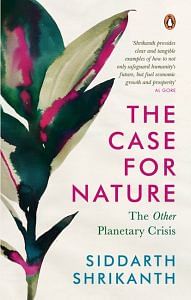When I first heard of the Intrinsic Exchange Group (IEG), I will admit I was puzzled by their proposition to create a new type of company they call a ‘natural asset company (NAC)’ in partnership with the New York Stock Exchange (NYSE).
The idea seemed to be that these NACs, an alternative to structuring these investments in nature as traditional companies or projects, would adopt a bespoke accounting system – Statements of Ecological Performance – as a parallel to the financial statements issued by regular corporations. NACs would both be a store of value and a way to capture the economic benefits of the many ecosystem services that lands, whether natural or working, can produce. As lands are preserved or restored, positive externalities (carbon, biodiversity, clean air and water, and so on) could be translated into financial capital, through avenues like sustainable sourcing, carbon and other ecosystem-service markets. The underlying assets could appreciate, much as a house does, to reflect restoration efforts.
Douglas Eger, Chairman and CEO of IEG, explained why he had gone down this alternative path, and how IEG had convinced that august institution of the old guard, the NYSE, to team up with them.
Eger urged me to think beyond the constraints of the finance and accounting classes I had sat through. ‘A lot of what people are valuing with natural capital isn’t captured by traditional accounting standards. Why do we accept this [model] as the only way we can create wealth – this model of “I have inputs of material and labour. I sell a product. Magically, I have profit.”?’
Also read: Private universities must offer urban planning courses if Indian cities are to be rescued
The basic principle of IEG’s new model looks like this: a company might list its agricultural land as an NAC, with shareholders buying into the new company to participate in its growth. Over time, regenerative agricultural practices might improve the underlying value of the land and generate ecosystem services that would be detailed in the NAC’s ecological statements. The NAC’s share price would be designed to go up, and inventors could trade stocks in NACs freely, as they do with traditional companies. The core of this would be a company that values its natural capital fully and gets rewarded financially for improving its stocks and flows.
Eger explained the practical benefits for a cooperative of farmers who might want to go down the NAC route. ‘To fund regenerative agriculture, for instance, there can be a small premium. But you have to find a way to include the production of ecosystem services along with commodity crops. The NAC model [enables] the financing of on-farm changes, the supply chain, and delivers to the end user an improved product.’
Unlike some other natural finance innovators we’ve met, Eger was insistent that a new paradigm for the stock-market itself was necessary to bring natural markets to life. To him, the creation of Natural Asset Companies was a necessary evolution of the natural capital framework we’ve explored in this book, by adapting balance sheets to include natural capital, rather than describing natural risks and impacts using only the existing language of traditional finance.
If IEG and NYSE are able to pull off this seemingly outlandish idea, it seems likely that the financial ecosystem would be better off. Perhaps, one day soon, the initial public offering bell at the New York Stock Exchange will ring regularly for NACs committed to restoring the planet, and provide a welcome break from the apparently endless march of consumer-products companies selling their greenwashed visions of growth and prosperity to would-be investors.
Also read: Kodaikanal’s radioactive seafood diet, how mercury was added to the menu
With the fate of the planet at stake, we have to be willing to go out on a limb for some of these financial inno – vations. When the Dutch East India Company (Vereenigde Oost-Indische Compagnie or VOC) conducted the world’s first IPO in 1602, it must surely have been met with puzzlement and scepticism. Those sceptics may well have felt vindicated as the stock price soared and collapsed in the tulip bubble that followed. But the VOC ultimately carried on until the turn of the nineteenth century, by which time the joint stock corporation had become the unshakeable global default.
There are other features of the financial system that may well be worth adapting to nature-positive business models. One that stands out is the system of ratings agencies, the S&P Global and Moody’s of the world, that allow investors to assess corporate credit risk independently and virtually instantly. London-based start-ups BeZero and Sylvera, along with US-based Renoster, are examples of a new breed of ratings agencies, combining tech-enabled ecosystem monitoring with diligent analytical work to create global ratings agencies tailored to the voluntary carbon market.
BeZero, for instance, has rated hundreds of projects in much the same way as a traditional financial player might do for corporate balance sheets; a AAA-rated project might have, in their words, a ‘high likelihood of achieving 1 tonne of CO2 e avoidance or removal’, as opposed to an A-rated project with a ‘low’ likelihood. BeZero have appraised all sorts of projects, from a peatland conservation project in Indonesia that was rated AAA to a clean cookstove project in Guatemala that received a lowly A.
‘When we first looked at the voluntary carbon market, there was absolutely zero correlation between our assessment of the quality of the carbon project and the price per tonne that was being charged… so that reflects a complete lack of transparency within the marketplace,’ Nick Atkinson, Chief Science Officer at BeZero, told me. My own experience of the carbon markets confirmed this assessment: investing in the first wave of carbon projects was akin to buying a stock or bond with no idea about the underlying financial performance or credit rating of a company – not unheard of in the heady days of the pandemic stock-trading boom, but certainly not ideal for the functioning of a healthy market.
‘The idea is that we can provide a dispassionate rating for the carbon impact of the project, and that then gives transparency to the investor or the buyer of that carbon tonne. They know that if they see a carbon credit that’s rated at a lower level, they might have to buy two credits for every time that they want to offset.’ Ratings agencies often get things wrong, as the main financial agencies did during the 2008 crisis; still, they constitute an important tool for investors and buyers who lack the ability to deeply assess each individual project.
Philip Platts, BeZero’s Head of Earth Observation and an ecologist by training, was most concerned about the impact of an opaque carbon market on conservation outcomes. ‘If good projects aren’t getting well rewarded and aren’t being well run, then that’s a hindrance to conservation. On the flipside, if they can be well run and the price of a carbon credit can be more accurately linked to a good that it’s doing in terms of carbon, and in terms of livelihoods as well, it can become a massive vehicle for making inroads for conservation.’ For now, BeZero is focused on carbon markets, but rating co-benefits for UN Sustainable Development Goals or biodiversity are next on their list.
 This excerpt from Siddarth Shrikanth’s The Case for Nature has been published with permission from Penguin Random House.
This excerpt from Siddarth Shrikanth’s The Case for Nature has been published with permission from Penguin Random House.



